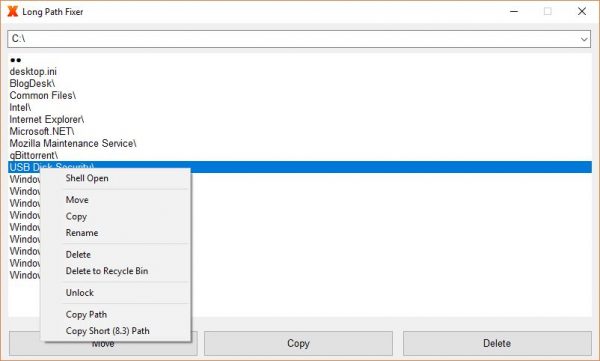

- #Long path tool key how to
- #Long path tool key update
- #Long path tool key full
- #Long path tool key windows 10
File Explorer even in the latest builds of Windows 10 20H2 and Windows Server 2019 still doesn’t support NTFS long paths. Win32 Long Paths GPO Not Working on Windows 10 File Explorer

In Visual Studio 2019 and MSBuild 16, this setting is enabled by default. If applications are developed with NTFS long path support, then the longPathAware parameter must be added to the manifest file. As usually, such an option is enabled via the application manifest file.Īn application manifest is a small file that contains some information about application compatibility, DPI support, etc. Keep in mind, that in order to use win32 NTFS long path, the application should be developed with this parameter enabled. If the command returned a value of 1, then the policy is enabled. If you want to check if NTFS long path support is enabled on this computer, you can run the following PowerShell command: Get-ItemProperty "HKLM:System\CurrentControlSet\Control\FileSystem").LongPathsEnabled Now the files will only be affected by the NTFS file path limit of 32767 characters. After a reboot, users and programs will be able to work without restrictions with files, which length of the path exceeds 256 characters. In both cases, the computer needs to be rebooted to make changes to take effect.
#Long path tool key update
Save the changes and update local group policy settings.

Open the policy parameter named Enable Win32 long paths and set it to Enabled. Go to the following GPO section in the policy editor: Computer Configuration > Administrative Templates > System > Filesystem. Or you can enable long path support via the Local Group Policy Editor (Win + R -> gpedit.msc -> OK ). You can change this registry parameter with the following PowerShell command: Set-ItemProperty -Path HKLM:\SYSTEM\CurrentControlSet\Control\FileSystem -Name LongPathsEnabled -Value 1 To enable the built-in support for long paths in Windows 10/Windows Server 2016/2019, use the Regedit.exe editor to set the LongPathsEnabled parameter of REG_DWORD in the registry key HKLM\SYSTEM\CurrentControlSet\ControlFileSystem with a value 1. Since Windows 10 Anniversary Update (1607), it became possible to disable the MAX_PATH limit for manifested win32 and Windows Store apps on the Windows operation system level without using prefix \\?.

#Long path tool key how to
How to Enable Long Path Support in Windows 10 (1607) and Higher Now you will be able to copy the files/folders into this location without receiving the error. Next, perform file operations with the directory to which the symbolic link is assigned (c:\homelink in our case). To create a link, you can use the following command: mklink /d c:\homelink “C:\verylongpathhere……” Create a Symbolic LinkĪnother option is to create a symbolic link to a part of the path, thus shortening the total path length. The simplest way is to shorten the name of the parent folders, decreasing the total path length (but not always applicable) by simply renaming it.
#Long path tool key full
Rename Parent Folder to Decrease the Full Path Destination Path Too Long error on Windows 10 20H2 Solution 1. You can shorten the file name and try again, or try a location that has a shorter path. The file name(s) would be too long for the destination folder.


 0 kommentar(er)
0 kommentar(er)
